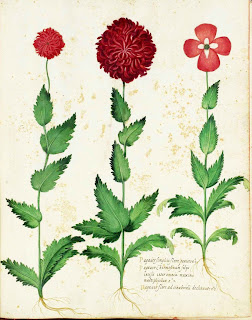Hi
everyone! I was looking through our herbal that I’m adding information to, and
I realized that I’m very much lacking flower info! I’m awaiting one source,
called simply, “A Medieval Book of Flowers,” which looks very beautiful and helpful.
One article I came across also is all about the history of the carnation
flower, of which we have a type in our Heraldic Garden here at Loyola. It’s written
by our good friend and expert medieval botanist John H. Harvey.
Carnations,
Harvey tells us, are mistakenly believed to be an ancient flower of Britain but
“it now seems far more probable that the real carnation, the old double red
clove, is the most modern of all the classical plants brought into cultivation
[in England] before the great age of introductions.”[1] He
tells us how the confusion arose, beginning from ancient Rome: Pliny
misidentified it as a particular plant from Spain used in flavoring. (The plant
actually was in Spain, from the East and under a different name, and the Spanish
carnations were named differently than Stock/Wallflower.) Then the confusion
was compounded further by William Turner, who mistakenly called Pliny’s flower
the English “wylde gelouer or gelefloure.”[2] This
flower is known now as “gillyflower,” however, it was “not found in [that]
spelling until 1535…” Once more, confusion added to confusion, as the English
called many things ‘gilliflower.’[3]
So
what are we left with? Well Harvey comes to the conclusion that carnations were
first “in Turkey and the Middle East, and also in Western Europe,” but the
latter not until “after 1500.”[4]
Harvey concludes this by careful study of pictorial images from the Mediterranean
and also lists and gardening documentation in medieval England. Harvey also
follows the trails left by these documents through the plant’s cultivation in
turkey, to when the “Ottomans had crossed into Europe at the Dardanelles in
1353” and brought it West, so we could eventually enjoy it. [5]
A medieval Italian rendering of a carnation. From http://vintageprintable.swivelchairmedia.com/botanical/botanical-flower-various/botanical-flower-carnation-italian-13/
As
always, stay warm, if you’re a teacher or student at Loyola then enjoy your break,
and hopefully I’ll see you at the garden when it’s nicer outside!


No comments:
Post a Comment